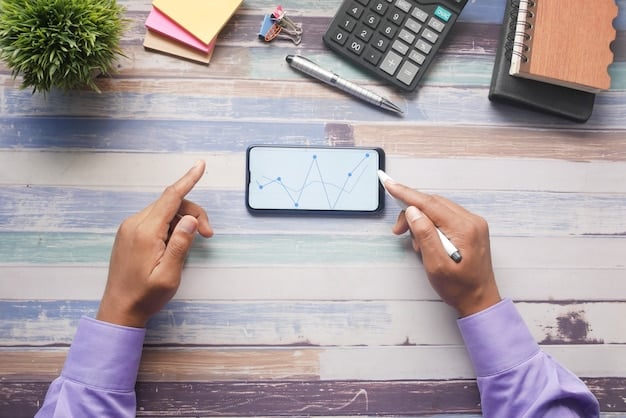Build a $10,000 Emergency Fund in 12 Months: A Grocery Savings Guide

Building a $10,000 emergency fund in 12 months is achievable by strategically implementing grocery savings, a key area of personal finance often overlooked for its significant impact on discretionary income.
Embarking on the journey to establish a robust emergency fund is a pivotal step in securing your financial future. Many paths lead to this goal, but one of the most effective, yet frequently underestimated, avenues lies within the realm of everyday spending: your grocery budget. This guide will show you how to embark on the important financial journey of building a $10,000 emergency fund in 12 months, primarily by mastering grocery savings strategies.
Understanding the Importance of an Emergency Fund
An emergency fund serves as your financial safety net, a crucial buffer against life’s unexpected turns. Whether it’s a sudden job loss, an unforeseen medical expense, or a major car repair, having readily available funds can prevent you from sinking into debt or making rash financial decisions. This foundational aspect of personal finance provides peace of mind and true financial resilience.
When considering the benchmark of $10,000, it’s not an arbitrary figure. For many households, this amount can cover 3-6 months of essential living expenses, aligning with common financial advice. The goal of accumulating this sum within a year, while ambitious, is entirely attainable with methodical planning and disciplined execution, particularly by focusing on controllable expenditures like groceries.
What Constitutes an Emergency?
It’s vital to differentiate between a true emergency and a desired purchase. An emergency fund is not for vacations, holiday gifts, or elective home improvements. Rather, it’s for situations that genuinely threaten your immediate financial stability or well-being.
- Unexpected job loss or significant reduction in income.
- Medical emergencies or unforeseen health costs not fully covered by insurance.
- Major home repairs (e.g., roof leak, furnace breakdown).
- Car repairs essential for transportation to work.
By defining “emergency” clearly, you ensure your fund remains intact for its intended purpose, preventing diversions that could compromise your financial security.

The psychological benefit of having an emergency fund cannot be overstated. It reduces financial stress and allows you to approach unexpected challenges from a position of strength rather than panic. This mental well-being is as valuable as the monetary security it provides, enabling clearer thinking and more strategic decision-making during difficult times.
Building this fund over 12 months requires consistency and commitment. It’s not about making drastic, unsustainable cuts, but rather implementing smart, consistent strategies that free up cash flow month after month. The focus on grocery savings is particularly potent because it’s a recurring expense that offers vast opportunities for optimization without significant lifestyle sacrifices.
Assessing Your Current Financial Landscape
Before you can begin aggressively saving for your $10,000 emergency fund, you need a clear picture of where your money is currently going. This initial assessment is non-negotiable and forms the bedrock of any successful financial plan. Without understanding your income and expenses, setting realistic savings targets becomes mere guesswork.
Begin by tracking all your income sources and every single expenditure for at least a month. Categorize these expenses meticulously, from housing and transportation to entertainment and, critically, groceries. Many people are genuinely surprised by how much they spend in certain categories once they see the numbers laid out plainly.
Creating a Realistic Budget
Your budget is not a straitjacket; it’s a roadmap. It helps you allocate your income purposefully, ensuring that your financial resources are aligned with your goals. When aiming for a $10,000 emergency fund in 12 months, your budget must reflect a commitment to saving approximately $833 per month.
- Calculate Income: Tally all net income (after taxes and deductions).
- List Fixed Expenses: Mortgage/rent, loan payments, insurance premiums. These are typically non-negotiable in the short term.
- Identify Variable Expenses: Utilities, transportation, dining out, and groceries. These are the categories where you have the most flexibility to make immediate changes.
- Allocate for Savings: Prioritize your emergency fund contribution first, treating it like a non-negotiable bill.
This systematic approach helps identify areas where spending can be reduced without compromising essential needs. The goal is to find that $833 monthly surplus, and for many, a significant portion of it can be found within the grocery budget.
Reviewing your budget regularly, ideally weekly or bi-weekly, allows for adjustments and keeps you accountable. Life happens, and your budget should be dynamic enough to adapt to changes in income or unexpected expenses, while still keeping your eye firmly on the emergency fund goal. Understanding your spending habits is the first and most empowering step towards financial control.
Grocery Savings: The Cornerstone of Your Emergency Fund
Groceries represent one of the most substantial and controllable variable expenses for most households. A concentrated effort here can free up significant capital for your emergency fund, making the $10,000 goal not just possible, but highly achievable. This section dives deep into actionable strategies that can redefine your relationship with food shopping and budgeting.
The average American household spends hundreds of dollars on groceries each month. By implementing smart strategies, it’s not uncommon for families to cut their grocery budget by 20%, 30%, or even more, translating directly into hundreds of dollars saved monthly that can be channeled into your emergency fund. This isn’t about deprivation; it’s about intelligent consumption.
Meal Planning for Maximum Savings
One of the most effective ways to reduce grocery waste and overspending is thorough meal planning. Before you even step foot in the grocery store, you should know exactly what you’re going to eat for every meal of the week. This minimizes impulse buys and ensures you only purchase what you need.
- Assess Current Inventory: Check your pantry, fridge, and freezer before planning. Incorporate ingredients you already have to reduce new purchases.
- Plan Around Sales: Look at weekly store flyers and plan meals around items that are on sale.
- Utilize Ingredients Fully: Plan meals that use common ingredients efficiently to avoid spoilage (e.g., using half an onion in one meal and the other half in another).
- Batch Cooking: Prepare larger quantities of meals or ingredients to use throughout the week, saving time and often money.
By diligently planning your meals, you reduce food waste, a silent budget killer, and ensure every dollar spent at the grocery store contributes directly to your nutritious intake, not to discarded food. This disciplined approach to meal planning directly impacts how quickly you can accrue emergency funds.
Savvy Shopping Strategies
Beyond meal planning, the act of shopping itself offers numerous opportunities for savings. These strategies require a bit of foresight and patience but yield significant returns.
Comparison shopping, buying in bulk judiciously, and understanding unit pricing are paramount. Don’t be loyal to just one store; different stores excel in different product categories, especially when it comes to sales cycles. A few extra minutes of research before your trip can result in substantial savings over the month.
- Couponing and Apps: Actively seek out digital and physical coupons. Many grocery stores have their own apps with exclusive deals and loyalty programs.
- Store Brands vs. Name Brands: Often, store brand products are identical or very similar in quality to name brands but come at a fraction of the cost.
- Seasonal Produce: Buying fruits and vegetables when they are in season is often cheaper and they taste better.
- Strategic Bulk Buying: Only buy non-perishable items or items you frequently use in bulk if the unit price is genuinely lower and you have storage space. Avoid buying perishables in bulk that might spoil before you can consume them.
The cumulative effect of these seemingly small decisions is powerful. Each dollar saved at the checkout is a dollar that can be transferred directly to your emergency fund. This mindful approach to grocery shopping transforms it from a chore into a strategic component of your financial growth.
Cutting Costs Beyond the Grocery Store
While grocery savings are a powerful lever in building your $10,000 emergency fund, it’s wise to explore other avenues for cost reduction. A multi-pronged approach ensures you maximize your savings potential across various categories, accelerating your journey towards financial security. Think of it as finding money in unexpected places to fuel your primary goal.
Examining all your monthly expenditures with a critical eye can reveal surprising opportunities for savings. This isn’t about living a life of austerity, but rather identifying non-essential expenditures that can be temporarily reduced or eliminated to fast-track your emergency fund accumulation.
Identifying and Eliminating Unnecessary Expenses
Take a deep dive into your bank statements and credit card bills. Many subscription services, unused gym memberships, or frequent impulse purchases add up to significant amounts over the course of a year. These are often “silent drains” on your income.
Consider the cumulative impact of daily habits. That morning coffee bought from a café, those frequent takeout meals, or the latest streaming service you barely use—each one, individually small, becomes substantial when tallied monthly. Redirecting these funds can make a remarkable difference.
- Review Subscriptions: Cancel any unused streaming services, apps, or memberships. Even $10-$20 per month adds up quickly.
- Dine Out Less: Eating at home is almost always cheaper than dining out. Aim to reduce restaurant visits or transition to cheaper alternatives like packed lunches.
- Cut Down on Impulse Buys: Implement a 24-hour rule for non-essential purchases. If you still want it after a day, consider it then.
- Optimize Transportation: Can you walk, bike, or use public transport more often? Could you carpool? Small changes here save on gas and wear-and-tear.
Every dollar saved outside of groceries is an additional dollar that strengthens your emergency fund. This holistic approach to frugality ensures you’re leaving no stone unturned in your quest to build a robust financial safety net.
Negotiating and Reducing Bills
Many recurring bills are not set in stone. Services like internet, cable, and even insurance premiums can often be negotiated down. A simple phone call can sometimes yield significant monthly savings that directly contribute to your emergency fund. This is a quick win that requires minimal effort for potentially large returns.
Don’t assume your current rates are the best available. Companies often offer better deals to new customers, and a polite inquiry often results in finding a better price. Loyalty doesn’t always pay; sometimes, asking does.
- Internet/Cable Providers: Call your provider and ask if there are any new promotions or if they can match a competitor’s offer.
- Insurance: Shop around for car and home insurance quotes annually. Even if you stay with your current provider, having competitor quotes can aid negotiation.
- Cell Phone Plan: Review your data usage. Are you paying for more data than you need? Consider a more basic plan.
- Energy Consumption: Simple habits like unplugging electronics, turning off lights, and adjusting thermostat settings can shave dollars off utility bills.
These proactive steps in managing your existing expenses are just as vital as finding new income streams or cutting down on discretionary spending. They demonstrate a comprehensive approach to financial management, all propelling you toward your $10,000 emergency fund goal.

Automating Your Savings and Tracking Progress
Setting up an emergency fund is not just about making conscious choices; it’s also about building systems that support your goals. Automation and consistent progress tracking are essential components to ensure you stay on course for building your $10,000 emergency fund in 12 months.
Outsourcing the discipline to your banking system is one of the smartest moves you can make. The less you have to think about manually moving money, the more likely you are to stick to your goals, turning your savings into a habit rather than a constant decision.
Setting Up Automatic Transfers
The “pay yourself first” principle is a cornerstone of effective personal finance. This means that as soon as you receive your paycheck, a predetermined amount of money is automatically transferred from your checking account to a designated savings account for your emergency fund.
- Separate Account: Set up a separate, easily accessible savings account specifically for your emergency fund. Keeping it distinct from your regular checking account reduces the temptation to dip into it for non-emergencies.
- Automatic Transfers: Configure your bank to automatically transfer your target monthly savings amount ($833) shortly after your payday. If $833 feels too steep initially, start with a smaller, consistent amount and gradually increase it as you find more savings through grocery strategies and other cost-cutting measures.
- Increase as You Go: As you become more proficient at saving on groceries and cutting other costs, adjust your automatic transfer amount upwards. Celebrate these incremental victories.
This automation removes the psychological barrier of “deciding” to save each month. It transforms saving into a non-negotiable part of your financial routine, much like paying a bill, ensuring consistent progress even when your motivation might wane.
Monitoring Your Progress
Regularly reviewing your emergency fund’s growth is crucial for motivation and accountability. Seeing your fund grow provides tangible proof that your efforts are paying off and reinforces positive saving behaviors.
Use spreadsheets, budgeting apps, or even a simple notebook to track your emergency fund balance. Visually charting your progress can be incredibly motivating. Consider setting smaller milestones within the 12-month period, celebrating each one to maintain momentum.
- Monthly Check-ins: On a specific day each month, review your emergency fund balance and compare it against your target.
- Adjustments: If you’re falling behind, reassess your budget and look for additional areas to save. If you’re ahead, consider increasing your monthly contribution slightly.
- Celebrate Milestones: Acknowledge your progress at $2,500, $5,000, $7,500, and finally, $10,000. These small celebrations can keep you engaged.
By making your saving journey visible and measurable, you transform an abstract goal into a concrete achievement. This systematic approach, coupled with strategic grocery savings and disciplined expense management, makes the target of $10,000 in 12 months not just a dream, but a very real outcome.
Maintaining Momentum and Long-Term Financial Health
Achieving the $10,000 emergency fund in 12 months is a phenomenal accomplishment, but it’s just one step in a lifelong journey of financial well-being. The strategies you implement to reach this goal—particularly those related to grocery savings—are not temporary fixes but valuable habits that should be integrated into your financial lifestyle for sustained success.
Financial health is an ongoing process, not a destination. The discipline and awareness cultivated during this intense savings period will serve as powerful tools for future financial goals, whether it’s saving for a down payment, retirement, or another significant life event.
Beyond the Emergency Fund: Next Financial Steps
Once your emergency fund is fully funded, avoid the temptation to relax your financial discipline entirely. Instead, redirect the formidable savings habit you’ve built towards other critical financial objectives. This continuous improvement mindset is what truly builds wealth over time.
Consider what your next financial priority will be. For many, it’s paying down high-interest debt, investing for retirement, or saving for a significant purchase. The framework of consistent saving and strategic expense management remains relevant for all these goals.
- Tackle High-Interest Debt: If you have credit card debt or other high-interest loans, redirect your monthly emergency fund contribution to accelerate debt repayment. This immediately frees up more cash flow.
- Invest for Retirement: Increase contributions to your 401(k), IRA, or other investment accounts. Compounding interest is a powerful ally for long-term growth.
- Saving for Specific Goals: Whether it’s a down payment on a house, a child’s education, or a dream vacation, designate a new savings goal and continue your automated transfers.
The agility to pivot your savings focus from an emergency fund to other financial goals is a testament to the strong habits you’ve developed. Each successfully met financial milestone builds confidence and capacity for the next.
Integrating Grocery Savings as a Lifestyle
The grocery savings strategies that helped you build your emergency fund are not just temporary methods; they are sustainable practices that can significantly reduce your everyday expenses indefinitely. By continuing these habits, you ensure ongoing financial flexibility.
Meal planning, smart shopping, and minimizing food waste should become ingrained habits. These practices not only save money but often lead to healthier eating habits and a more organized household. They contribute to a more mindful approach to consumption overall.
- Continue Meal Planning: Make it a weekly habit to plan your meals, incorporating sales and using ingredients efficiently.
- Regular Price Checks: Stay aware of unit prices and compare deals. Don’t fall back into the trap of impulse buys or overpaying.
- Utilize Leftovers Creatively: Reduce food waste by reimagining leftovers into new meals or freezing them for later.
- Be Flexible: Allow for occasional treats or dining out, but always with awareness and within a planned budget, rather than as a default.
Ultimately, building a $10,000 emergency fund in 12 months, especially with a strong emphasis on grocery savings, is about more than just accumulating money. It’s about empowering yourself with financial literacy, discipline, and the confidence to navigate life’s uncertainties. This foundation sets you up for enduring financial fitness.
| Key Strategy | Brief Description |
|---|---|
| 🛒 Meal Planning | Plan meals weekly around sales and existing pantry items to prevent impulse buys and waste. |
| 💰 Smart Shopping | Utilize coupons, compare unit prices, choose store brands, and buy seasonal produce. |
| ✂️ Cut Expenses | Reduce unnecessary spending like subscriptions and dining out, and negotiate recurring bills. |
| banked Automation | Set up automatic transfers to a dedicated emergency fund account and track progress diligently. |
Frequently Asked Questions About Building an Emergency Fund
▼
Financial experts generally recommend having 3 to 6 months’ worth of essential living expenses saved in your emergency fund. For many individuals and families, a $10,000 fund adequately covers this range, providing a robust safety net against unforeseen circumstances.
▼
The crucial first step is to assess your current financial situation by tracking all income and expenses. This helps create a realistic budget, identify areas of overspending, and determine how much you can realistically allocate towards savings each month without significant hardship.
▼
Absolutely. Groceries are a major variable expense for most households. By implementing disciplined meal planning, smart shopping strategies (like using coupons and buying generic), and reducing food waste, many people can consistently save hundreds of dollars monthly, directly impacting their emergency fund growth.
▼
It’s generally advised to build a small starter emergency fund (e.g., $1,000) first. This provides a basic safety net. After that, focus on high-interest debt. Once high-interest debt is eliminated, return to fully funding your emergency savings to the recommended 3-6 months of expenses, like the $10,000 goal outlined.
▼
Your emergency fund should be kept in a separate, easily accessible savings account, ideally one that earns a decent interest rate but isn’t subject to market fluctuations. Online savings accounts often offer higher interest rates than traditional brick-and-mortar banks, allowing your money to grow a little even while it sits there.
Conclusion
Establishing a $10,000 emergency fund within 12 months is an ambitious yet entirely attainable financial goal, especially when approached with strategic planning and consistent execution. As demonstrated, leveraging grocery savings is not merely a supplementary tactic but a powerful, central pillar in this endeavor. By meticulously budgeting, implementing savvy shopping practices, and cultivating financial discipline across all spending categories, you empower yourself to build a robust safety net. This journey not only secures your immediate future against unforeseen events but also instills invaluable habits that foster long-term financial resilience and well-being. The path is clear; the tools are at your disposal. Begin today, and witness your financial security grow.





